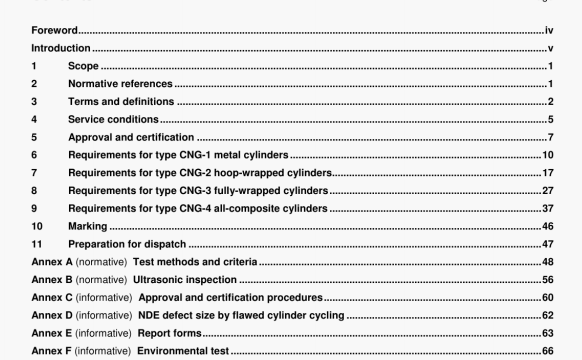ISO 11439 pdf download – Gas cylinders一. High pressure cylinders for the on-board storage of natural gas as a fuel for automotive vehicles.
d) should more than 3 months have expired since the last pressure cycle test, then a cylinder from the next batch of production shall be pressure cycle tested in order to maintain the reduced frequency of batch testing in b) or C) above:
e) should any reduced frequency pressure cycle test cylinder in b) or C) above fail to meet the required number of pressure cycles (minimum 22 500 or 30 000 pressure cycles, respectively), then it shall be necessary to repeat the batch pressure cycle test frequency In a) for a minimum 0110 prodUction batches in order to re-establish the reduced frequency of batch pressure cycle testing wi b) or c) above.
Should any cylinder in a). b) or C) above tail to meet the minimum cycle life requirement of I 000 cycles multiplied by the specified service life in years (minimum 15 000 cycles), then the cause of tailure shall be determined and corrected following the procedures in &9. The pressure cycle test shall then be repeated on an additional three cylinders from that batch. Should any of (he three additional cylinders fall to meet the minmum pressure cycling requirement of 1 000 cycles multiplied by the specified service life in years, Then the batch shall be rejected.
6.7 Tests on every cylInder
Production examinations and tests shall be carried out on all cylinders produced Ni a batch. Non-destructive examinations shall be carried out in accordance with a standard acceptable to the Inspector.
Each cylinder shall be examined dunng manufacture and after completion as follows:
a) by NDE ii accordance with annex B or proven equivalent method to verily that the maximum defect size does not exceed the size specified In the design as determined wi accordance wIth 6.34, The NDE method shall be capable of detecting the maximum defect size allowed:
b) to verify that the critical dimensions and mass of the completed cylinders are within design tolerances:
C) to verify compliance with specified swface finish with special attention to deep drawn surfaces and folds or laps in the neck or shoulder of forged or spun end enclosures or openings.
d) to verily the markings:
a) by hardness tests of heal treated cylinders In accordance with A8. the values thus determmed shaft be In the range specified for the design;
I) by hydraulic test 01 finished cylinders in accordance with A. 11. If Option 1 is chosen, the manufacturer shall establish the appropriate lm’iil of permanent vokjmetric expansion for the test pressure used, but in no case shall the permanent expansion exceed 10% of the total volumetnc expansion measured under the test pressure.
6.8 Batch acceptance certIficate
If the results of batch testing according to 6.6 and 6.7 are satisfactory, the manufacturer and the Inspector shall sign an acceptance certificate. An example of an acceptance certificate (referred to as a RePOrI of Manufacture and Certificate of Conformance is given in annex E.
6.9 Failure to meet test requirements
In the event of failure to meet test requirements, re-testing or re-heat treatment and re-testing shall be carried out as follows to the satisfaction of the Inspector:
a) II there is evidence of a fault in carrying out a test, or an error of measurement, a further test shall be performed; If the result of this test Is satisfactory, the first test shall be Ignored:
b) If the test has been carried out in a satisfactory manner, the cause of test failure shall be identified,
1) It the failure is considered to be cie to the heat treatment applied, the manufacturer may sutiject all the cylinders implicated by the fallL%e to a luriher heat treatment i.e. it the failure Is In a test representing the prototype ci batch cylinders, test failure shall require reheat treatment of all the represented cylinders prior to re-testing; however if the failure occurs sporadically in a test applied to every cylinder, then only those cylinders which fail the test shall require re-heat treatment and re-testing.
— Whenever cylinders are reheat treated, the minimum guaranteed wall thickness shall be maintained.
Only the relevant prototype ci batch tests needed to prove the acceptabdity of the new batch shall be performed again. Il one or more tests prove even partially unsatisfactory, all cylinders of the batch shall be rejected.
2) If the failure is due to a cause other than the applied heat treatment, all defective cylinders shall be either rejected or repaired by an approved method. Provided that the repaired cylinders pass the test(s) reiired for the repair, they shall be re-instated as part of the original batch.
ISO 11439 pdf download – Gas cylinders一. High pressure cylinders for the on-board storage of natural gas as a fuel for automotive vehicles
